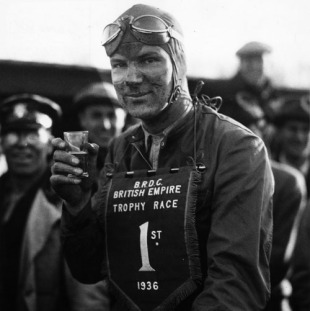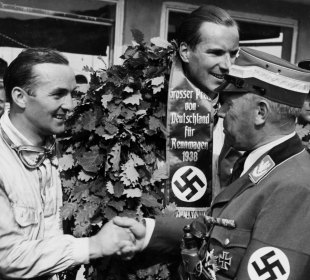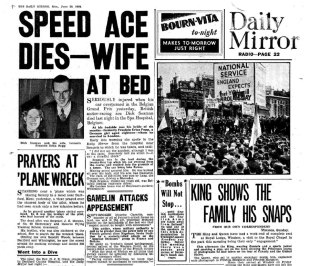
At London's Putney Vale Cemetary two of Britain's finest motor racing drivers from either side of the Second World War are buried. Their names are Richard Seaman and James Hunt, but you may only have heard of one of them.
It is 75 years since Seaman died after crashing out of the lead of the 1939 Belgian Grand Prix behind the wheel of a Mercedes - the pride of Nazi Germany - two months before his homeland and Germany went to war. He was just 26 years old. At his funeral on June 30 in London, a city that was soon to be ravaged by The Blitz, Nazi dignitaries in attendance left a huge wreath at his grave personally signed by Adolf Hitler.
Were it not for Seaman's Faustian pact on the eve of seven years of war with Germany, we might remember him better as the nation's greatest pre-war driver, having ended a seven-year drought for the British when he won a European Championship grand prix in 1938. That it happened to be while driving a silver car adorned with a swastika in front of 300,000 fans at the Nurburgring explains why his name has not lived on as it may have otherwise. On the top step of the podium Seaman gave the Nazi salute, an action he is remembered for more than any other. Arguably the biggest tragedy of his sad story is that it was ambition and not political ideology which led him to Mercedes.
Born to a wealthy family in 1913, Seaman had originally been groomed for diplomatic service or Parliament but soon defied his parents, leaving Cambridge University early to embark on a motor racing career. His father was unimpressed and threatened to disinherit him but died of a heart attack while travelling to London for a final confrontation with his son in the early 1930s.

Attitudes towards racing in Germany and Britain at the time could not have been more different. In Britain it was seen as little more than a hobby for the rich, but the motor car had become a core part of Hitler's vision for the Third Reich. The seemingly invincible Mercedes and Auto Union racing cars of the late 1930s were a way to demonstrate Germany's engineering supremacy to the world.
An Englishman signing for a German team might have been frowned upon at home, but to Hitler and Josef Goebbels it was seen as a propaganda opportunity. While recovering from a crash at the 1937 German Grand Prix, Seaman showed the Duke of Windsor and his Duchess Wallis Simpson, notorious Nazi sympathisers, around the Mercedes-Benz headquarters just months after the abdication crisis had nearly torn Britain apart.

Even Seaman's personal life seems intertwined with the narrative of pre-war Europe, meeting Erica Popp, the daughter of the director of BMW, at a function in the restaurant next to the Burgerbraukeller from which Hitler had launched his failed Munich putsch in 1923. Popp's father - a close friend of the Fuhrer - would consent to their marriage on September 15, 1938, the day before British prime minister Neville Chamberlain first travelled to meet Hitler in Munich, eventually returning home two weeks later with a signed piece of paper supposedly guaranteeing peace for his time.
At Mercedes, Seaman's star continued to grow. In February 1938 he was presented to Hitler at the annual motor show in Berlin. Team-mates Rudolf Caracciola and Manfred von Brauchitsch - number one and two drivers at Mercedes - grew increasingly wary of Seaman's improving performances; frequently ignoring the man they bitterly called "Der Englander".
Nine days after meeting his future wife in Munich came the pinnacle of Seaman's career, driving his V12 Mercedes 154 to victory at the Nurburgring in July 1938, ignoring a team order not to beat Von Brauchitsch - whose uncle Walther had just been appointed the army's commander-in-chief - and denying the Nazi machine a perfect propaganda tale. The Englishman's victory still won him the adoration of the German population and Hitler himself. Standing on the podium, before he gave his infamous salute, Seaman turned to photographer and friend George Monkhouse and whispered "I just wish it had been in a British car."
Later that year he went ahead with his marriage to Erica despite an ultimatum from his mother, Mrs Beattie-Seaman, who was terrified at the prospect of half-German grandchildren and subsequently cut him out of his inheritance. She would never see her son again. A contract extension for Seaman followed in 1939 but concerned by the prospect of war, Mercedes severely limited his drives. With no support from his mother and no other income Seaman now had to consider leaving Mercedes to continue his career.

Before he could, however, he travelled with Mercedes to Spa for the 1939 Belgian Grand Prix. Even the original German rain master Caracciola spun out of the torrential conditions, handing the lead to Seaman. Lapping faster and faster, determined to prove his own prowess in the wet and earn a second major victory, Seaman eventually spun out on Lap 22, his car igniting in a ball of flames after hitting a tree. Horrifically burnt, he was taken to the local hospital where he briefly regained consciousness, long enough to remark to his chief engineer: "I was going too fast for the conditions. It was entirely my fault, I am sorry."
His death just before midnight of June 25 robbed Britain of its greatest pre-war driver. The news received a few lines on the front page of the Daily Mirror, ironically and perhaps fittingly placed above an article about French commander-in-chief Maurice Gamelin condemning the appeasement policy which had seen nations turn a blind eye to Nazi Germany's actions at home and abroad.
Undoubtedly, Seaman was a driving talent Britain did not see again until the emergence of Mike Hawthorn and Stirling Moss in the 1950s. Though he admired German efficiency and what the Nazi influence had helped Mercedes achieve, Seaman did not identify with the radical elements of National Socialism. He put his own ambition before duty to his country and it is the war which took place after his death which left him a nearly-forgotten figure in Britain's proud racing heritage.

Nate is assistant editor of ESPNF1

